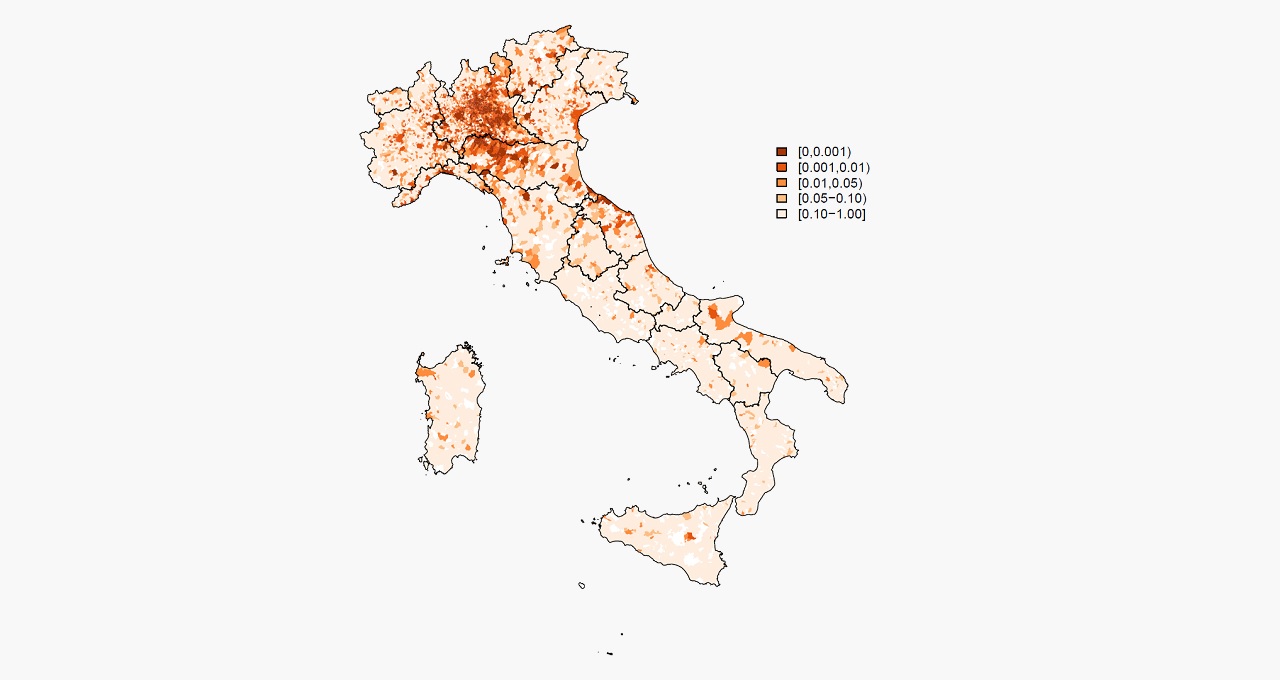A municipality-level Analysis of Excess Mortality in Italy in the period January-April 2020
Publication date: 10/07/2020 – E&P Code: repo.epiprev.it/1911
Authors: Annibale Biggeri1, Dolores Catelan1, Mario Braga2, Corrado Lagazio3, Fabio Barbone
Abstract: The first confirmed cases of Covid-19 in WHO European region was reported at the end of January 2020, and from that moment the epidemic has been speeding up and rapidly spreading across Europe. The health, social and economic consequences of the pandemic are difficult to evaluate since there are many scientific uncertainties and unknowns. Several authors discussed the preventable methodologic errors that have arisen in reporting on the COVID-19 crisis. The use of excess mortality for all causes has been advocated as a less biased measure of impact. The main focus of this paper is on statistical methods for the identification of spatial clusters of excess mortality, directly or indirectly caused by Covid-19. In particular, we analyzed mortality for all causes at municipality level in Italy 2015-2020 and compared excesses observed January-April 2020 with the corresponding period in the previous 5 years. Mortality data were made available by the Ministry of Internal Affairs Italian National Resident Population Demographic Archive and Italian Central Statistical Institute (ISTAT). We obtained for each municipality the posterior predictive distribution under a hierarchical null. We calculated the one-sided tail probabilities over the posterior predictive distribution using the observed death counts. Post processing of posterior predictive probabilities is conducted to account for multiplicity. Excess death counts are obtained using the posterior relative risk using as reference the municipality-specific expected count – the mean of the posterior predictive distribution – and the observed 2020 death counts. Attributable Community Rate is also calculated using the population denominators. Full Bayesian models implemented via MCMC simulations were conducted. The scientific community has been debating on the extent of the consequences of the pandemic in Italy or, in other terms, on how many deaths were caused by the virus well above the seasonal mortality. Our study is not intended to answer this question, but to provide a methodological approach to analyze epidemic data accounting for the spatial and temporal uncertainty.
Cite as: Annibale Biggeri, Dolores Catelan, Mario Braga, Corrado Lagazio, Fabio Barbone (2020). A municipality-level Analysis of Excess Mortality in Italy in the period January-April 2020. E&P Repository https://repo.epiprev.it/1911
Topic: COVID-19
Key words: COVID-19, distribuzione predittiva, eccesso di mortalità, statistica bayesiana,
AVVERTENZA. GLI ARTICOLI PRESENTI NEL REPOSITORY NON SONO SOTTOPOSTI A PEER REVIEW.
A municipality-level Analysis of Excess Mortality in Italy in the period January-April 2020
Info
Affiliations:
1 Department of Statistics, Computer Science, Applications “G. Parenti” University of Florence (IT)
2 Tuscany Health Agency (IT)
3 Department of Economics, University of Genoa (IT)
4 Department of Medical Area, University of Udine (IT)
Authors’ contributions: –
Competing interests: None
Funding disclosure: –
Ethics committee approval: The study was based on publicly available aggregate data. No Ethics committee approval was necessary.
Copyright: Il detentore del copyright è l’autore/finanziatore, che ha concesso a “E&P Repository” una licenza per rendere pubblico questo preprint. The copyright holder for this preprint is the author/funder, who has granted E&P Repository a license to display the preprint in perpetuity.
Terms of distribution: CC BY-NC

Fig. 3 (detail). Q-value based on Posterior Predictive Probabilities by Municipality. March 2020, Italy
References & Citations
Google Scholar

